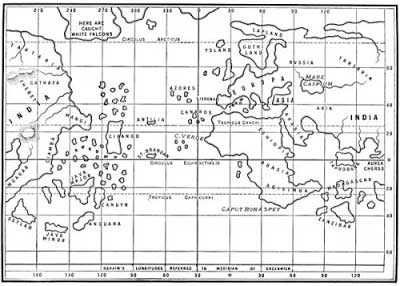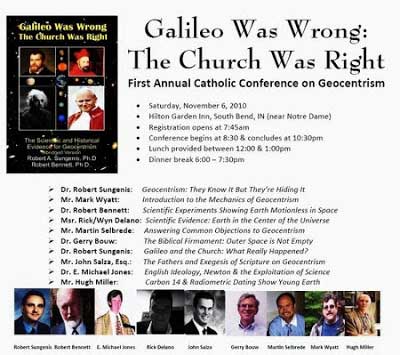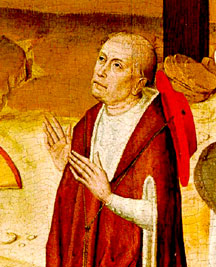
The map (to the right) displays how Columbus and some other fifteenth century Italians imagined the earthʼs geography looked, click here for more info. Columbus died, still thinking he had reached islands near India. We will discuss Columbus (along with the influence theology had on Medieval map making, and myth-making) again at the end of this blog entry but for now itʼs enough to note that Columbus was no flat earther.
But long before Columbus (and even before the Church Fathers), writings and imagery from the ancient Near East demonstrated that ancient Egyptians, Mesopotamians and Hebrews agreed the earth was flat and stationary. Even the authors of inter-testamental works like Daniel and Enoch (written between the time of the “Old Testament” and the “New Testament”) assumed the earth was flat. Even the authors of the New Testament, in the first century, employed ideas and phrases appropriate to the flatness of the earth, and also appropriate to a three-tier cosmos with Godʼs heaven above, earth below and “sheol/hades/tartarus” lying “under” the earth—all such Greek terms being translated in the New Testament with the Germanic word, “hell” (see “The Cosmology of the Bible,” a chapter in The Christian Delusion, click here, and see “Is Flat Earth Biblical Cosmology merely an Infidelʼs Delusion?” click here).
Furthermore, the idea of the sun, moon, and stars, having waters set firmly above them was discussed by early rabbis as well as Church Fathers, and medieval Christians, in fact right up till Martin Lutherʼs day at the dawn of the Reformation in the fifteenth century. See this pic from Lutherʼs Bible:
Only after the invention of the telescope did enough data pour in such that ancient ideas and words of Scripture no longer determined how the cosmos was viewed (with some modern day Christians still in denial, from geocentrists to young-earth creationists, click here. While other Evangelicals are striving to get their brethren to understand the ancient Near Eastern background of Genesis 1, click here, here, and here.
Returning to the question of what the Church fathers believed, the majority were not flat earthers but sought a concordance between the Bible and the notion of a spherical earth as found in the Hellenstic world, the same world that the Church Fathers wished to evangelize. Though a few did reject the “pagan” notion of a spherical earth, click here for more info.
One Christian in particular, writing under the pseudonymn, “Cosmas Indicopleustes,” who lived toward the end of the reign of the Christian Emperor Justinian in the sixth century, attacked the pagan “spherical earth” view and defended instead the view that the earth was flat, based on the idea in the Letter to the Hebrews that the earth was like Godʼs tabernacle in the Old Testament in which God dwelt. His book was called Christian Topography, click here. Ironically, modern day Evangelical Christian scholars (including inerrantists like John Walton, and G. K. Beale, as well as apologists like N. T. Wright) agree that the setting up of the cosmos according to Genesis chapter 1 should be interpreted as the building and consecration of a “temple” for God to dwell in—which resembles the view of Cosmas, i.e., that the cosmos was shaped like the “tabernacle” used by Moses in the wilderness, a “tabernacle” being a sort of movable “temple.” [see ENDNOTE #1] So these modern day Evangelicals view Genesis 1 as a story about the creation of the cosmos based on the motif of “temple mythology.” Cosmas would probably be annoyed at the rejection of his literal interpretation, yet also pleased to at least hear that his tabernacle/temple idea has withstood the test of time and even been applied to the first chapter of the Bible.
Even as late as the eighth century at least one medieval Christian wrote a book that depicted the earth in flat terms, attributing his work not to himself in the eighth century but to an author before Cosmasʼ own day. The book was titled, The Cosmography of Aethicus Ister, click here for a description.
And even though most Church Fathers accommodated themselves to the prevalent Hellenistic idea of a spherical earth, note that a major Church Father like Augustine denied that human beings lived on the other side of that sphere.
Saint Augustine (354-430 CE):
But as to the fable that there are Antipodes, that is to say, men on the opposite side of the earth, where the sun rises when it sets to us, men who walk with their feet opposite ours that is on no ground credible. And, indeed, it is not affirmed that this has been learned by historical knowledge, but by scientific conjecture, on the ground that the earth is suspended within the concavity of the sky, and that it has as much room on the one side of it as on the other: hence they say that the part that is beneath must also be inhabited. But they do not remark that, although it be supposed or scientifically demonstrated that the world is of a round and spherical form, yet it does not follow that the other side of the earth is bare of water; nor even, though it be bare, does it immediately follow that it is peopled.
Since these people would have to be descended from Adam, they would have had to travel to the other side of the Earth at some point; Augustine continues:
It is too absurd to say, that some men might have taken ship and traversed the whole wide ocean, and crossed from this side of the world to the other, and that thus even the inhabitants of that distant region are descended from that one first man.
Flat earthism underwent a bit of a revival in the early 1900s when some Christians in both Britain and the U.S. cited Scripture in its support and defended it in the face of what they called the “evils of modern astronomy.” British supporters of a flat earth challenged spherical earth scientists to public debates, and the flat earthers were said to have won over their audiences. In the 1920s in the U.S. Wilbur Glenn Voliva built one of the most powerful radio transmitting stations in his day, and broadcast his flat earth views widely from the city of Zion, Illinois, a Christian religious community that upheld the flat earth view.
According to Robert J. Schadewald, who was researching a book on the history of Flat Earth movements before he died in 2000, there are still flat earthers today:
[The late] Charles Johnson, a twentieth century Flat Earther and editor of The Flat Earth News, was sort of a wacky character, but he was not really representative of flat earthers in general. The half dozen or so other flat earthers Iʼve spoken or corresponded with have included a successful Boston trial lawyer, a priest who belongs to a society devoted to the preservation and translation of ancient Coptic manuscripts, a retired financial officer from a major metropolitan school system (he thoughtfully corrected an error in Greek grammar I had copied from a flat earth source), and a young man who intended to translate an eighth century flat earth treatise by Aethicus of Istria from Latin into English. Not exactly a bunch of semiliterates!
Schadewald added:
The Antiochene Fathers of the early Christian Church more or less invented the historical-critical method of exegesis popular among modern fundamentalists within the Reformed tradition. (Not surprisingly, *every* Antiochene Father whose views on the subject I have been able to discern was a flat earther!) So I think it is a bit strong to suggest that this method doesnʼt have ‘anything to do with the history of Scriptural interpretation.’ It may have been moribund for a long time, but it has ancient roots. [Emails dated 8/10/99 and 8/5/99 respectively from the late Robert Schadewald, author of numerous articles on “flat earthism,” and author of the unpublished work, The Plane Truth: A History of Flat Earth Science.]
For some articles by Schadewald that touch upon the history of nineteenth and twentieth century flat earth groups click here.
Not only do the flat earthers whom Schadewald met attest to that beliefʼs presence in the year 2000, but some twenty first century flat earthers appear to have set up a serious web forum, click here.
T-shirt sold at TheFlatEarthSociety.Org
Geo-centrism is yet another view that has never died out among believers in the Bible who cite Scriptures in support of their belief. Early Church Fathers were geocentrists, as well as the Fathers of Protestantism, Luther and Calvin (click here). Today there are still geocentrists among some orthodox Jewish educational institutions (click here). Geocentrism is also promoted by some Catholics and Protestants, who held a joint conference recently, attempting to augment their Bible-based belief in geocentrism with “scientific arguments,” click here.
A T-O type map, from 1300 (Hereford Cathedral, England) with Jerusalem at center, east toward the top, Europe at bottom left and Africa on the right. |
Columbus & Ptolemyʼs Geography
Columbusʼ fifteenth century view of the size of the earth was based on Ptolemyʼs second century Geography book. Ptolemy calculated that a degree was 50 miles (not 70 as we know today), which gave him an earth with a circumference of only 18,000 miles. Ptolemy also stretched Asia eastward for 180 degrees (not 130 degrees as we know today). Therefore, Columbus, taking the word of a book composed thirteen hundred years before he was born, thought India was far closer than it really was.
Why was Ptolemyʼs Geography still considered relatively accurate thirteen hundred years after its first publication? Europe had become Christian. Expanding knowledge of the physical world was deemed to be of relatively less importance than theological notions concerning the world, especially the “world to come.” In fact there was no English word for “geography” until the 16th Century.
A classical T-O Map, but this one is from a printing press, not hand drawn like the one above, and far from being the earliest. It dates to 1472. |
At any rate, Columbus appears to have used a version of Ptolemyʼs smaller size of the earth along with a belief that less sea probably existed and more land (per II Esdras, see below). So when he did reach land he remained convinced he had discovered islands off the coast of India. Columbus also noted the existence of fresh waters from what we know today as the Orinoco river which implied a great river and a vast continent. Christian geographers said that such could not exist south of the equator. So, he decided that he had found the location of Paradise. Columbus grew increasingly religious in his later years and wrote, A Book of Prophecies (1505), in which passages from the Bible were used to place his achievements as an explorer in the context of Christian eschatology.
Other Peculiar Notions About Geography That Were Held During the Middles Ages
The Insignificant Ocean—A passage found in the Catholic Bible (and in early Protestant Bibles that used to include the Apocrypha), implied that the earth was mostly land rather than sea. The “Ocean,” was believed to be a body of water that surrounded the earthʼs three major continents (Europe, Asia, Africa) in a circular fashion, but not as expansive as the continents themselves. The verse in question was this one:
Upon the third day [of creation] thou didst command that the waters should be gathered in the seventh part of the earth: six pats hast thou dried up, and kept them, to the intent that of these some being planted of God and tilled might serve thee. [II Esdras 6:42, II Esdras is an ancient Apocryphal work included in Catholic Bibles, but also included in early Protestant Bibles, even the first edition of the King James Bible]
The verse implied that six sevenths of the world must be land, so the ocean was believed to be far smaller than we know it to be today. The “Ocean” simply meant a circle of water that surrounded the three major continents of the world, with Jerusalem in the center. While beyond the “Ocean” lay Paradise.
Early Medieval maps, driven by theological rather than geographical concerns, often pictured Asia at the top [east was at the top] and Europe and Africa beneath Asia, one on the right, the other on the left, all three continents being encircled by the “Ocean,” with a “T”-shaped body of water dividing the three continents. The upright trunk of the “T” was the Mediterranean Sea, the right cross bar of the “T” being the Nile river, and the left cross bar of the “T” being the Danube river (or some other major European river).
- It was also commonly believed that the three known continents, Europe, Asia, and Africa, constituted the entire world, and that each continent was occupied primarily by the descendants of one of the three sons of Noah after they left the ark, and/or after the dividing of the world after the tower of Babel incident, with Jerusalem lying at the “center of the world.”
In short, Medieval map makers came up with ways to design maps that supported Christian theological beliefs. Different portions of the Bible provided added opportunities for creative cartography.
At the top of the T maps, also called T-O maps, geographers placed the Garden of Eden. (Keep in mind the top was Asia, the east.) Typically surrounded by a mountain range or a high wall, outside of which was a wasteland filled with wild beasts. Popular tales told of monks who traveled to locate Eden.
Saint Brendan (484-578), an Irish monk, apparently believed Eden was in the Atlantic. He reportedly sailed west and found a beautiful island paradise. “St. Brendanʼs Island” remained on maps until at least 1759, even though it was never found by anyone else.
The books of Ezekial in the Old Testament and Revelation in the New Testament both warned of “Gog and Magog,” so they were added to maps. Usually located in the extreme north (per Ezekielʼs description). Roger Bacon urged the study of geography to prepare for an invasion from Gog and Magog.
In the twelfth century during the Crusades, Europe sought allies in the Holy Land. Prester John was said to be a priest-king who had defeated the Muslims in his kingdom. Allegedly descended from the same race as “the Three Wise Men” (who traveled far to deliver gifts to the baby Jesus), Prester John was also allegedly a pious Christian, military genius, and an enormously wealthy ruler. About 1165, a letter appeared from Prester John to the Byzantine emperor of Rome and the King of France allegedly promising to help them to take back Jerusalem from the Muslims. “Prester Johnʼs Letter” was extremely popular and widely published. It included mention of such things as: “birds called griffins who can easily carry an ox or a horse into their nest to feed their young.” “Horned men who have but one eye in front and three or four in the back.” Bowmen “who from the waist up are men, but whose lower part is that of a horse.” For years, mapmakers continued to attempt to locate Prester Johnʼs kingdom.
A Catalan Atlas from 1375, made for King of Aragon by Abraham Cresques, a Jew on Majorca, was created by combining empirical geographical knowledge gained from ships of trade with theologically based ideas. Jerusalem was still near the center of the earthʼs geography, Gog and Magog still present.
The cartographerʼs greatest act of self-control was to leave parts of the earth blank. A difficult act of self-control indeed, as eons of cosmological speculation and mythmaking—from the time of the ancient Near East till today—demonstrates.
Endnotes
#1 Some Bible scholars argue that the story of a “tabernacle” in the “wilderness” might also be a myth retrojected back into the Moses story, based on the later building of the temple in Jerusalem.



